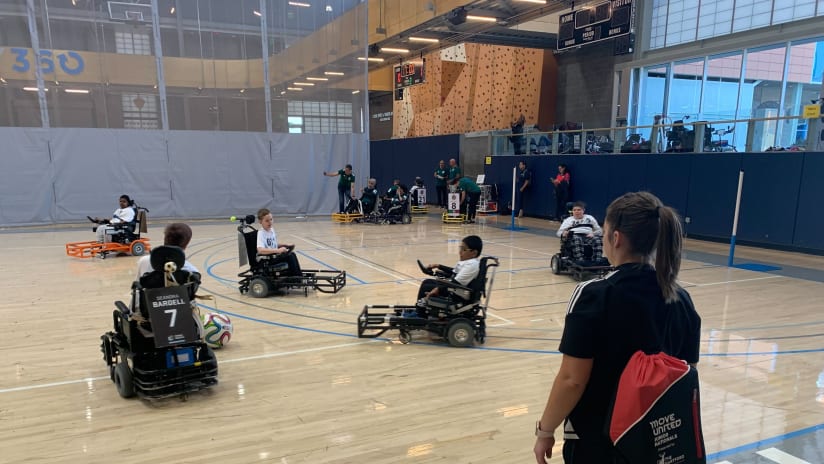The MLS All-Star Game may not have been at Allianz Field this season, but there are plenty of All-Stars around the North Star State getting ready for another talent showcase. On Saturday, December 2, MNUFC is hosting a Power Soccer All-Star Game at Brooklyn Center High School at 11:30 a.m.
This game will be played in the middle of a day-long tournament between four power soccer teams from our region, making for an exciting celebration of these talented athletes. As MNUFC and Allina Health sought to find a way to recognize power soccer athletes from across the area, this tournament offered the perfect opportunity to lift up not only the sport itself but the people that make it so special as well.
In addition to the MNUFC Power Soccer team from Allina Health’s Courage Kenny Rehabilitation Institute (CKRI), two power soccer teams from Minnesota will be represented at the event, as well as one from just across the Wisconsin border. The Minnesota Shockwave hails from Big Lake, and the MN Northern Lights will be coming from Zimmerman. The Chippewa Valley Hooligans are the lone Wisconsinites, traveling from Ridgeland for the tournament.
With input from the coaches of each team, the Midwest Power Soccer Association selected the All-Star athletes for this event from a very talented pool, with emphasis on athletes that demonstrate MNUFC’s core values of resilience, inclusivity, dedication, teamwork, and respect. This region is among the best in the nation, with three Minnesota Shockwave athletes even competing on the US National Team.
With such a big event happening nearby, it's important to understand the history of this unique game and how exactly it's played.
History of Power Soccer
Even before the United States Power Soccer Association was formally started in 2006, the sport was played across the globe. In the early 1970s, a group of French school teachers created the first version of power soccer, called French Powerchair Football.
The rest of the world followed, with the game coming to North America in 1982 by way of Canada’s “motor soccer.” By 1988, the United States had joined, rebranding the sport as power soccer at UC Berkeley. After years of development and discovery through playing, power soccer as it is known today was formalized when representatives from France, Canada, Japan, England, Belgium, Portugal, and the US met in Coimbra, Portugal, to standardize the rules and kick off what would become an international sport.
The result of their meeting was the formation of the International Powerchair Football Association (IPFA) in 2005. With 250 teams across the world, the sport is alive and well, especially in Minnesota.
CKRI, a part of Allina Health, played a large role in bringing power soccer to our state, hosting the MNUFC Power Soccer Team and helping to organize awesome events like this All-Star Game. With several other teams dotting the Minnesota landscape, the North Star State is at the forefront of this sport's continued growth.
Rules and Recreation
So, you’ve got the history down; now let’s learn the rules. Power soccer is played on a standard-sized basketball court, with two teams of four players on the court at a time. Each match consists of two 20-minute periods, during which teams attempt to get the ball between their opponents’ goal posts.
Each player is in their own wheelchair, with a footguard attached to the front for striking the ball. The ball itself is 13 inches, about twice the size of the standard soccer ball.
The match is officiated by three referees: two sideline officials and one center official. While the flow of the game closely resembles soccer as you know it, there are a few unique rules that differentiate it. The 2-on-1 rule states that only one player from each team is allowed within three meters of the ball while it’s in play, spreading the field out and forcing players to pass the ball long distances.
The 3-in-the-area rule states that a defending team can only have two players in their own goal area at a time. Once again, this forces players to position themselves well and remain cognizant of where their teammates are. Both of the rules highlighted here have exceptions, but you can see the general idea behind them: spread the game out, and keep it even.
Visit powersoccerusa.org to learn even more about how the game is played, and make sure you bring a piece of that Allianz Field atmosphere to Brooklyn Center High School on December 2! This is one event you’re not going to want to miss.




